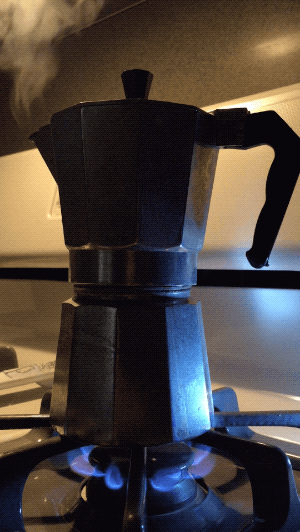
Coffee is, of course, a serious thing in Italy. And it’s all about quality versus quantity. Those espressos are one mouthful, but it’s a mouthful to be savored, to be held on the tongue and allowed to linger long after the cup is actually raised to the lips.
My coffee needs work. In fact, it’s managed to silence a room on more than one occasion.
Making coffee at home in Italy seems simple enough, but it’s not. I don’t know exactly what I’m doing wrong. It could be that I’m packing my Lavazza too firmly into the little round compartment or not packing it enough. It could be that I’m scalding it. I just don’t know.
My last crime against coffee was perpetrated on a couple of handymen who’d come to do a few things like installing a handrail along the stairs and hanging a heavy bathroom mirror. After they’d been at the house for a couple of hours and were pretty close to packing up, I offered them coffee, and they and Antonio sat down at the kitchen table and dug into a plate of anise cookies while they waited. It being early afternoon, I also put out bottles of Brancamenta and Sambuca should they want to have a caffè corretto, the term for coffee with a shot.
Evidently, even booze couldn’t salvage my coffee.
After I’d delivered the little cups to the table and gone back about my business, I became aware of a quiet behind me. The clacking of dishes as I washed them was the only sound in the room. When I turned and asked if the coffee was okay, there was the kind of shell-shocked silence I'd expect had I asked the men if they thought their mothers were still sexually active. Antonio nodded and pursed his lips for a few seconds, buying time, then declared it “interessante” while the other guys concentrated hard on clearing the cookie crumbs from the table around their plates and making sure none escaped to the floor. Neither of the two made eye contact with me or with each other, determined as they were to gather every last crumb. I laughed, to the apparent relief of the company, who finally looked up from their labors. I apologized, but spared them the offer to make another round because I knew I’d lost all credibility.
As the conversation resumed, I started hearing a lot of a word I didn’t know: ciofeca. Turns out it’s a kinda colorful term for things that are sorta crappy, coffee in particular. The guys were quick to assure me that the word had nothing whatever to do with the brew I’d served up. It was just the natural progression of the conversation, you understand, since we were talking about coffee and all. I wondered if the next stop in the natural progression of the conversation would be why Americans were buying houses in Abruzzo, anyway. Well, as it happens, I’d just written the above when I stumbled onto this helpful article from a publication for expats in Italy about making a good cup of espresso. If you’re interested, scroll down to the section that begins with “The water.” Here are the highlights, though.
Use water with as little sodium as possible.
When you pour the water into the base, don’t cover the valve inside. It blocks the steam vent.
Amount of coffee is a matter of disagreement, but it seems you shouldn’t pack the coffee into the top, and should be sure it won’t spill into the area around the seal.
Coffee should be prepared over a medium flame and stopped before it gurgles. (I thought hearing it gurgle and seeing the liquid spill over meant it was done. Apparently, by then it’s already burnt.)
Some little points of interest about coffee:
I don’t know if this is true of other regions but, in Abruzzo, it’s common to sweeten coffee with honey. I guess it’s a great idea as a more healthful substitute for sugar, but I find the combo of flavors unpleasant.
Two popular alternatives to traditional coffee at Italian cafes these days are caffè d’orzo, made of roasted barley and caffeine-free, and caffè al ginseng, a combination of espresso powder and ginseng root.
Veganism is growing in popularity in Italy as it is here. You can now get a good soy cappuccino at a lot of cafes.

There’s a practice that started in Naples, where the coffee is the stuff of legend, called il caffè sospeso, or suspended coffee. Customers order and pay for two coffees, the second “suspended” for someone else — anyone, really — who wouldn’t be able to afford it. There’s even a book about everyday wisdom that bears the title.
Related article: